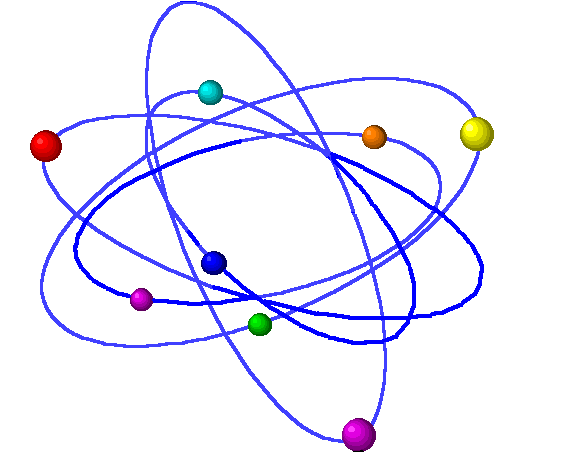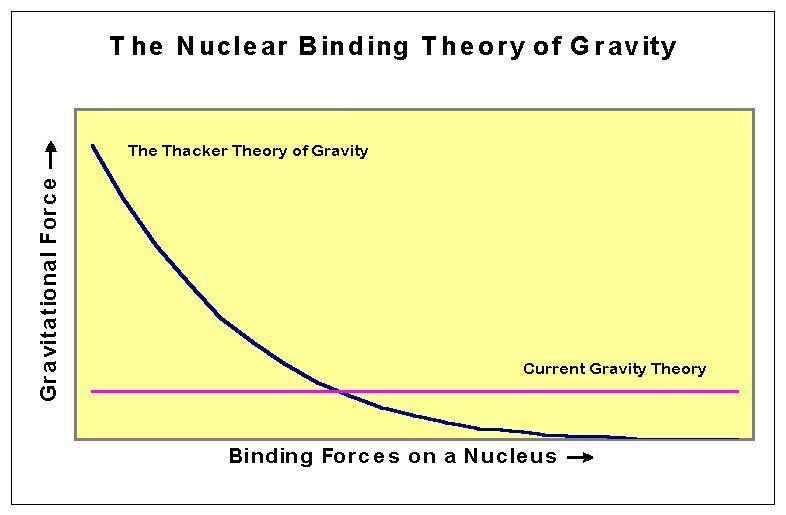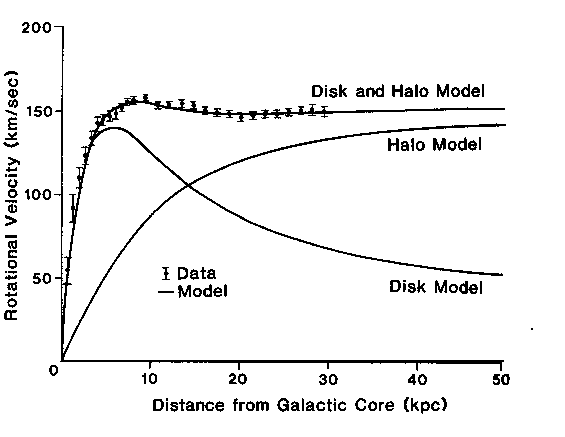
A New Look At Gravity
© 2001 Jerrold Thacker
Ever since Newton "discovered" that wonderful force called gravity, the assumption has been universally made that gravity is a constant property of mass. That is, the force of gravity is proportional to the mass of an object. This concept is so ingrained in our upbringing that, to my knowledge, it has never been challenged or doubted!
But what if it were not so!
Numerous experiments over many years have proven that the gravitational potential of ordinary matter is directly related to that matter's mass. A pound of gold has the same gravitational force as a pound of wood. Two bricks have twice the gravitational force of one brick. So what's the problem?
We've only measured gravitational forces for normal matter!
Matter comes in many forms. It would be surprising if all of its characteristics were to be retained in all forms. For example, an ordinary atom is known to consist of a nucleus of neutrons and protons, and a counterbalancing shroud of electrons. Study a large quantity of identical atoms and you define a set of characteristics for that element. If we now study a large quantity of this element which has been altered in some way (one or more electrons stripped away, or extra neutrons or protons added) we find changes to many of its characteristics.
Do we know that the gravitational force of this modified element is equivalent to its mass? No, we don't! Since any gravitational forces we can create in the laboratory are extremely small, conducting meaningful experiments about gravity is almost impossible. So our actual knowledge of the gravitational forces of matter is very lacking. It's easier just to assume the simplest hypothesis -- that gravitational force is directly related to mass.
Gravitational and Inertial Mass
Scientists normally state that gravitational mass and inertial mass are equivalent. That is, MassGravity = Constant * MassInertia. This is a very handy concept, since inertial masses are quite easy to measure, while gravitational masses are not (unless the item can be weighed on a scale). We can't "weigh" the moon or a planet, but by their orbits we can determine their inertial mass, and therefore by inference their gravitational mass.
The trouble with this is that this equivalence has never been proven under all cases (if indeed for any!). And it is suspect. A physical object reacts to other objects by the attractive forces of gravity. But inertial mass is an entirely different phenomenon, and totally unrelated to the idea of "attractive force". There seems to be no reason to equate the two, except for convenience. In the following I will try to clarify this.
Looking inside the atom
We're going to take a little trip inside an atom. Nothing complex, but just enough to illustrate a point.
Let us assume that the gravitational forces affecting an atom or molecule are caused by the impact of tiny particles called gravitons (this is a well-accepted idea). The exact nature of gravitons, or of the reaction within an atom, is unknown, but we know that the net effect is to accelerate the atom slightly in the direction that the graviton came from. (Of course this is greatly simplified!).
We might first ask if it is the nucleus of an atom, or an electron, which experiences the attractive action. Because electrons are very much smaller than the nucleus, we will assume that only the impact of a graviton on the nucleus is significant.
The following illustrates what might happen within a normal atom when the nucleus is hit by a graviton. At first the nucleus starts to move in the direction of the graviton (the attractive force). But the electrostatic forces of the surrounding electron shell force the nucleus back. The nucleus rebounds, and begins to oscillate within the electron shell. Eventually the nucleus will come to rest. Much of the attractive force of gravity has been absorbed by the exchange of forces between the nucleus and electron shell (which undoubtedly causes heat). The entire atom experiences a small but definite force toward the source of the graviton which, if the atom is imbedded in an object, is transferred to the object.
Now let us consider an ionized atom. That is, an otherwise normal atom with some of the electrons missing. When the nucleus is struck by a graviton, the effect is similar to a normal atom. However, since there are less electrons to inhibit the motion of the nucleus, its oscillations are more extreme, and in the end the atom reacts more to the gravitational attractive action of the graviton, even though it has less mass than the original atom.

In our third scenario, we look at an unattached nucleus -- one without surrounding electrons. These "free" nuclei are where there is extreme heat (millions of degrees) such at the center of the sun or a star, during nuclear fusion tests, and as high-energy cosmic rays.
In this case, when a graviton strikes the nucleus, there is no electron shell to inhibit the response of the nucleus. It immediately responds unabated to the graviton. It is Super Gravitational!
The bottom line is what I call the Thacker Nuclear Binding Theory of Gravity. In simple terms, it means that the gravitational force of an object is inversely proportional to binding force on the nucleus. This is illustrated in the following drawing:

Doesn't this violate some law?
In a word, NO! We've always been taught that gravity is constant, but that doesn't make it so. We know so little about gravity, and have so many unanswered questions in the universe, that we owe it to ourselves to see if this new theory can unlock some of the mysteries of astronomy. As you will soon see, it is amazing how many of these mysteries disappear when considered in this new light.
So what does this mean?
Just about everything! A whole new understanding of the universe! The following summarizes some of the implications.
The way that the Sun creates its energy (nuclear fusion) is thought to be very well understood, and extensive mathematics exist to describe the process. However, one of the most puzzling problems facing scientists today is that the Sun emits only 1/3 as many neutrinos as predicted. Scientists have absolutely no explanation for this.
The answer to this mystery is that the gravitational force of the Sun has two components -- one due to the normal mass which comprises the Sun, and a second component caused by super-gravitational free nuclei within its core. The Sun's mass has been estimated based on the Sun's gravitational interaction with the various planets. But if part of the Sun's gravitational attraction is due to the free nuclei at its center, then it actually has less normal matter than currently thought. Less matter means lower pressures and temperatures at the core, and thus less neutrinos generated within the core. The Sun may be only 2/3 as massive as currently thought! The rest of its gravitational power comes from free nuclei within its core.
Since the Sun has greater gravitational forces than represented by just the mass it contains, we can conceive of a class of stars called SuperStars. These stars have ordinary masses but their centers are so hot that very large quantities of free nuclei are created. These SuperStars would then have extremely high gravitational forces -- far out of proportion to the ordinary mass they contain, and far greater than the Sun.
In other words, some otherwise normal stars could have gravitational forces equal to millions, or even billions of times that of our Sun!
It is my contention that what astronomers call "massive black holes" are really SuperStars.
Quasars are known for the very high redshift observed in their spectrum. So far the only explanation put forth for this redshift is that they are traveling away from us at over 99.5% of the speed of light, and are billions of light years away. But this explanation is based on using the Hubble law to estimate their distances. Some very well respected astronomers have raised doubts that the Hubble law can be used for quasars. Besides, the energy they would have to have to be seen at such distances is beyond any explanation.
It is known that light emitted by an object with a gravitational field experiences a redshift due to the influence of the gravitational forces. This is known as the Gravitational Redshift, and was first predicted by Einstein. It has been measured for the Sun, the Earth and several nearby stars. At these normal gravitational forces, the gravitational redshift is very small.
Enter the SuperStars. A SuperStar would be quite small, but it has enormous gravitational force. The light it emits would experience a very large gravitational redshift. For example, a SuperStar with a gravitational attraction of a million Suns but with a radius of just 20 times that of the Sun would have a gravitational redshift of over z = 0.1. Such a large redshift would qualify this object as a quasar!
So we see that the Thacker Nuclear Binding Theory of Gravity provides a very satisfying explanation for the redshift of quasars which is independent of distance. They need not be billions of light years away, and are probably relatively ordinary stars not too far away. They are SuperStars with a very small size but huge gravitational forces. The redshift is caused by this gravitational field, and is the Gravitational Redshift described by Einstein.
Pulsars are thought to be rotating neutron stars which spew energy in the direction of our solar system once a revolution, much like a seaman would see the light from a revolving beacon once a revolution. But the discovery of millisecond pulsars introduces some problems to that concept.
One problem is that pulsars have been found which pulse energy up to 600 times a second. Neutron stars are thought to be about 10 miles in diameter, so this object would be spinning at 600 times a second, or 36,000 RPM. The rotational velocity of the surface of such an object would be almost 50% of the speed of light. To say the least this is mind-boggling.
A neutron star is thought to be the remnants of an ordinary star which has used all its fuel, cooled and collapsed until all its atoms are squeezed into close proximity by the forces of gravity. But according to the Thacker Nuclear Binding Theory of Gravity, once the nuclei are bound very tightly together, their gravitational forces become very low. Without gravity to hold the neutron star together it would explode due to the repulsive forces present.
Once a neutron star exploded and the nuclei once again became free, the forces of gravity would return and the atoms would then quickly come together to form a new neutron star. This cycle of explosion and reformation would continue indefinitely.
This pulsation (repeated explosion and reformation) could readily be the cause of the pulsar phenomenon instead of rotating neutron stars!
The ultimate in density is the Black Hole. The simplest explanation of a black hole is that it is basically a neutron star with a mass over 3.2 times that of our Sun. The term "black hole" derives from the concept that its gravitational force would be too large for light or anything to escape. It becomes a sink-hole in space.
If you read the paragraphs about pulsars and neutron stars, you can readily see that a black hole can exist for only a short time. Once matter has come together into the compact form of a black hole, virtually all gravitational forces would disappear and the black hole would explode, only to reform.
Perhaps that is why they are so hard to find -- the can only exist momentarily!
Scientists have been trying for many years to generate electricity by nuclear fusion. This is done by heating a plasma to extreme temperatures in a magnetic containment device. At these extreme temperatures, atomic nuclei are freed from their electron shells and allowed to combine with other free nuclei. The fusion of nuclei releases tremendous heat and energy, which if captured can generate large amounts of electricity.
The problem is that scientists can only sustain the fusion process for a short time -- a few seconds or minutes!
As we have been discussing, free nuclei such as generated during the fusion process are highly gravitational. It is possible that they simply exit the containment chamber at high speed, depleting the supply of free nuclei and causing the process to come to a halt.
This premise is subject to test by placing a highly sensitive gravimeter near a fusion reactor during trials, and observing the resulting gravitational field. If I am right, we may be on the track to finally harness the power of nuclear fusion for the peaceful production of power.
The significance of the preceding paragraph is that the Thacker Nuclear Binding Theory of Gravity can be verified by test!
Cosmic rays are known to be free atomic nuclei, and thus according to the Thacker Nuclear Binding Theory of Gravity, they should be highly gravitational. Scientists are at a complete loss to explain the origin and source of energy of some very high-energy cosmic rays.
The source of the observed high-energy can be explained if these free nuclei are drawn to the Earth at high velocity due to their very high gravitational forces. This concept is supported by cosmic ray research which indicates a "tail chase" phenomenon -- that is, there is a concentration of cosmic rays which appear to arrive at the trailing edge of Earth as it orbits the Sun -- exactly what you would expect if they were reacting to the gravitational force of the Earth.
Galaxies and Globular Clusters
If we admit to the existence of small objects with very large gravitational forces (either massive black holes or SuperStars), then we must look at the influence of their gravitational field on light from stars and other objects located beyond them. Since it is known that gravity deflects light, this must be taken into account.
Without going into any real detail at this time, let me state that we will see two images of nearly every object located beyond such an object. One of the images will be seen near the object, and a second will be seen near its true position. The result is the appearance of a large number of stars around the massive black hole or SuperStar. These are not real stars, however, but simply optical illusions -- duplicate images of distant stars located beyond the SuperStar.

Tucanae Globular Cluster. This is exactly what you would expect to see as a result of the bending of light around a SuperStar, or even a "massive black hole". The star images are duplicate images of stars behind the SuperStar, and are not real! A similar effect for a very distant SuperStar would give the appearance of a galaxy.
What I am suggesting is that the images of galaxies and globular clusters we observe in the universe can be explained by the bending of light around super-gravitational SuperStars. They may not be island clusters of billions of stars, as currently believed, but just optical illusions! If you asked me "are there real galaxies out there?", my response would be "I don't know, but maybe not.".
The Missing Mass in the Universe
Astronomers estimate that 90-99% of the mass of the universe is "missing", or invisible. They have observed unusual behavior in the motion of stars in orbit around many distant galaxies which cannot be explained with what we now know. One explanation is that this behavior would occur if there were a halo of invisible mass surrounding the galaxies. So that's the explanation accepted by astronomers.

The problem is -- after years of searching they still haven't found what it is!
I'm not going into the details here, but let me state that the observations which have led to the conclusion of missing mass can be explained (without the need for missing mass!) by the following factors:
At the center of the "galaxy" is a SuperStar, which is rotating around an axis roughly perpendicular to our line-of-sight to the "galaxy".
The star images are duplicate images of stars beyond the central SuperStar, and are not real stars.
The rotating SuperStar creates a rotating gravitational field around it. Star images on one side of the SuperStar experience a redshift as a result of being in the gravitational field longer, with the Shapiro effect causing the redshift, while star images on the opposite side are in the gravitational field a shorter time, and experience a relative blueshift as a result of acceleration by the rotating gravitational field. Because the Shapiro effect is dependent on the log of the distance from the SuperStar, the amount of redshift and blueshift is independent of distance from the center -- exactly what is found.
In other words, the star images we see in these galaxies are optical illusions caused by the bending of light by the very high gravitational field of the central SuperStar. Since the SuperStar is rotating, the gravitational field surrounding it is dragged along -- it also is rotating. Star images passing through this rotating gravitational field experience either a redshift or blueshift, depending on if they are moving against the moving gravitational field or with it. The Shapiro effect cancels out the effect of distance from the central SuperStar, so the effect is as we observe it, but not due to any missing mass.
It sounds complicated, and I guess it is, but astronomers have spent billions of dollars trying to find the missing mass, with no success. Perhaps this explanation will lead to a new understanding of the processes in our universe, and put an end to a futile search for missing mass which doesn't exist.
The Bottom Line
The Nuclear Binding Theory of Gravity provides a completely new look at our universe.
Back to the Main Page Contact Me